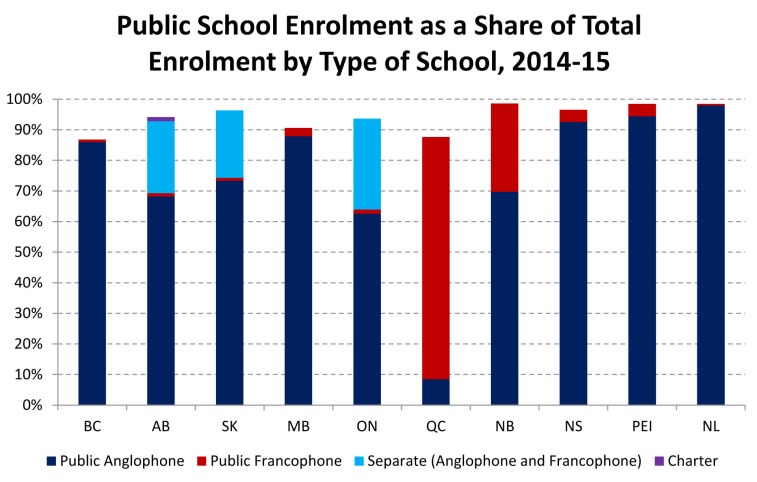School enrolment in Canada—a snapshot
All across Canada a greater share of students and their families are choosing independent schools or homeschooling while the share of students attending public schools in every province is in decline.
A recent Fraser Institute study showed a provincial decline (up to 3.8 percentage points) in the share of students attending public schools. The first chart below shows that British Columbia and Quebec stand out as the provinces with the greatest decline over the period from 2000/01 to 2014/15.

Despite the decline, choosing a public school is still the choice of the vast majority of families. In 2000/01 no province had less than 90.6 per cent of students in a public school. Fifteen years later every province still showed at least 86.8 per cent of all students attending some form of public school. In fact, in five provinces more than 96 per cent of students attend a public school.
So while independent schools and home schools are increasingly attracting a greater share of students, it remains the public schools that attract the greatest shares of students—even if a decreasing share—as shown in the second chart below.

A close examination of enrolments in the various public school systems in each province reveals shifts away from the traditional public school choice. In Canada that has usually meant the local English public school. Recall that all provinces have an English public school system and a French public school system, while three provinces (Alberta, Ontario and Saskatchewan) also have separate Roman Catholic schools as part of their public school systems. In addition, Alberta also has charter schools, which run more independently but are still a form of public school.
Consider English public first. In all provinces (but New Brunswick), the share of students enrolled in an English public school declined (between 2000/01 and 2014/15). In Alberta, for example, the share enrolled declined from 73.1 per cent to 68.1 per cent (a five percentage point decline). In British Columbia the share enrolled declined 4.3 percentage points, and in Saskatchewan 4.2 percentage points.
Then take French public school systems. In all provinces except Quebec and the bilingual province of New Brunswick, the share of students enrolled in a French public school increased. The share is small in most provinces but it is, generally, an increasing share.
So it seems defaulting to the local English public, or the local French public in the provinces where that is a dominant choice, is becoming less of a priority for parents. And where it wasn’t the dominant default, it’s increasing.
Now consider separate schools. The share of a province’s students attending an English Roman Catholic school increased, in Alberta up from 21.8 to 23.5 per cent, and Saskatchewan from 19.9 to 22.1 per cent. In Ontario the share in separate schools (totalled for both English separate and French separate) declined very slightly from 30.1 per cent to 29.7 per cent. Thus, when available, an increasing or consistent and sizable share of students are also choosing Roman Catholic schools rather than the local English public system.
Finally, consider charter schools. Although only permitted in one province (and capped at 15 schools), enrolment numbers more than tripled since 2000/01 and now account for 1.4 per cent of the share of all students in Alberta.
So let’s recap. The share of students in public schools overall is in decline. And within the public systems, for the most part, French public and Roman Catholic separate and charter schools are all increasing. That leaves the English public systems to account for the bulk of the decline.
Overall, however, one conclusion remains clear. While public schools are becoming less popular, parents are increasingly choosing non-government options for the education of their children.
Author:
Subscribe to the Fraser Institute
Get the latest news from the Fraser Institute on the latest research studies, news and events.

